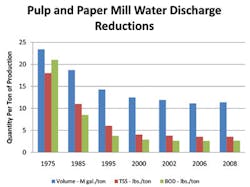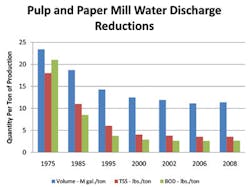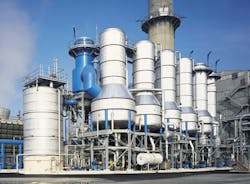Water Treatment in the Pulp and Paper Industry
By Jeff Gunderson, Industrial WaterWorld Correspondent
The pulp and paper (P&P) industry is one of the heaviest users of water within the U.S. industrial economy, requiring 54 cubic meters on average of water per metric ton of finished product. With water used in nearly every step of the manufacturing processes, P&P mills produce large volumes of wastewater and residual sludge waste, presenting a number of issues in relation to wastewater treatment, discharge, and sludge disposal. However, increasingly advanced treatment technologies, including innovative strategies geared towards water reuse and resource recovery, present viable solutions for P&P manufacturers in terms of wastewater and solid waste management.
Contaminants inherent to P&P waste streams include effluent solids, sediments, absorbable organic halides (AOX), chlorinated organic compounds, and chemical oxygen demand (COD) and biological oxygen demand (BOD) contaminants. Table 1 lists potential water pollutants associated with various P&P operational processes.
According to industry experts, approximately 85% of the water used in the P&P industry is used as process water, resulting in relatively large quantities of contaminated water and necessitating the use of onsite wastewater treatment solutions. Treatment options include primary treatment such as clarification to remove solids and particulate matter, and secondary biological treatment processes for removing biodegradable organic matter and decreasing the effluent toxicity.
Additionally, tertiary treatment technologies such as membrane filtration, UV disinfection, ion exchange, and granular activated carbon can also be employed to further treat effluent water to higher qualities.
Water Reuse
Growing water scarcity and heightened awareness associated with water conservation are prompting more industrial manufacturers to explore water recycling within facilities - a strategy which also reduces wastewater effluent volumes.
Water recycling is an attractive proposition for industries such as P&P that withdraw large volumes of water or have highly polluted waste streams and are subject to increasing charges for disposal, according to a market report by independent research and advisory firm Lux Research, which evaluated water usage and industrial water treatment across six of the top water users among manufacturing industries.
In Demystifying the Industrial Water Market, Lux Research found that recycling of water within the P&P industry is an increasingly common solution because it allows facilities to reuse water and also recover excess pulp fibers that have escaped in the wastewater, providing the industry with a high economic incentive to recycle its waste streams.
"Membrane technologies such as microfiltration, ultrafiltration, and nanofiltration are the most effective strategies for treating water to a level where it can be utilized in the beginning of a process," said Brent Giles, a senior analyst at Lux Research.
"Additionally, employing a careful choice of the chemicals added to treatment water also makes recycling easier," he added. "Using ozone instead of chlorine, for instance, eliminates long-term residual and makes the wastewater less caustic to the membranes."
Bernhard Doll, vice president of industrial water marketing at Pall, said the drivers for water reuse - and also water treatment plant upgrades - in the P&P industry include tighter water quality requirements, rising wastewater discharge costs, and increasing limitations on water withdrawal rights.
"These factors, along with corporate responsibility initiatives to reduce water usage, are motivating P&P plant operators to switch from conventional water treatment to membrane systems. In addition, water recycling is becoming more and more of a priority," he said.
Indeed, many of the progressive initiatives in the P&P industry in regards to water treatment and reuse have been a direct result of the growing importance in corporate and environmental responsibility, said Eric Meliton, an environmental technologies industry analyst with Frost & Sullivan.
"Just as with water usage, many of the changes that the industry has made on the treatment side have been in response to social and environmental stewardship initiatives," he said. "The P&P sector tends to be slow moving, but initiatives towards improving wastewater treatment metrics have shown to be very influential and can be an important driver toward evoking change across the industry."
While tertiary treatment of final effluent for reuse may have limited economic and technical feasibility for most P&P mills, many facilities have taken advantage of the opportunity to recycle individual process streams and reuse water that would otherwise be discharged to the wastewater treatment system, said Rich Garber, director of environment with Boise Inc.
"The paper industry has made great improvements in treating process water streams and recapturing residual pulp fibers, calcium carbonate, and water volume," he said. "For example, paper mills can treat paper machine 'whitewater' and recycle it back to the bleach plant for use as shower water and pulp dilution water. In addition to reducing discharge volumes, 'whitewater' recycling also helps lower energy use as this water contains valuable thermal energy, displacing steam needed to heat the process water."
Clean process condensate streams can also be reused in the pulping and recovery areas, Garber added, and P&P mills are employing heat recovery projects that extract heat from condensate streams in order to pre-heat process chemicals that are then used in the bleaching process.
Water recovery and reuse opportunities on the pulping side of the industry include specially-designed evaporative thermal processes that deal with black liquor waste. Mills can implement "condensate segregation processes that work by evaporating water out of concentrated black liquor from the pulping cycle, allowing for very pure water recovery and maximum reuse in the plant," said Kent Drone, director of processes engineering with HPD, a division of the Veolia Water Solutions and Technologies family of companies.
"A significant amount of water is used in the pulping process, and moving forward water reuse is anticipated to become increasingly more vital in this industry segment," Drone said. "As U.S. pulp mills continue to evolve, we anticipate more implementation of evaporator condensate purification and re-use processes for helping to lower water intake volumes and reduce loads on effluent treatment."
Sludge Management
As is the case with other industrial manufacturing processes, including wastewater treatment operations on the municipal side, residual sludge management presents a number of challenges to the P&P industry and represents a significant portion of a facility's total wastewater treatment costs.
Composed mainly of boiler and furnace ash, scrubber sludge, lime mud, wood processing residuals, and various effluent solids, sludge is the largest volume waste stream generated by the industry, making sludge handling a very important issue, according to Meliton.
"Many of the conventional, or 'old school' P&P manufacturers continue to employ traditional sludge management techniques that have been in place for many years and generally include sludge disposal methods such as incineration or land-filling," Meliton said. "But at the same time, it's important to realize that P&P sludge, with further treatment, has the potential to qualify as a biosolid, which can be used for a number of innovative solutions."
P&P mills can implement advanced technologies that convert waste sludge into fertilizer and biogas, offering a beneficial use of a waste stream and significantly reducing a facility's waste disposal burden.
"Manufacturers that are already meeting compliance requirements can elect to continue to pay the tipping fees and disposal costs associated with sludge waste disposal or they can make the necessary capital investments towards waste to energy applications that generate renewable energy and create fertilizer, offering a revenue incentive," Meliton said. "The decision is mainly based on whether or not the technology justifies the capital expenses in terms of a potential return on investment."
Some mills employing an alkaline-based manufacturing process can pursue beneficial use projects specifically because of the calcium carbonate present in their wastewater residuals, Garber said.
"Many paper mill wastewater residuals will have a high agricultural lime value. Depending on the region, the land type, and if the soils are particularly acidic, residuals with high lime content can be effective as a land application product," he said.
Anaerobic Digester Processes
While cogeneration of biogas from wastewater anaerobic digester processes for generating electricity and steam is an economical, long-term solution that is increasingly being pursued in the municipal sector, this approach has been relatively slow to gain traction in the P&P industry, mainly because of the high capital costs associated with implementation.
"Anaerobic digester processes are rarely used in the P&P industry," Garber said. "More frequently, energy recovery initiatives are based on taking dewatered solids produced from primary or secondary clarification and burning the material in wood-fired boilers for the production of steam, which powers most P&P mill processes."
Moreover, if a pulp or paper mill does use anaerobic digestion, the process will most likely not be used to digest sludge, Garber added.
"As an example, Boise Inc. has an anaerobic system in the Jackson, Alabama, mill that is used to treat segregated condensates from the pulping and evaporation processes which contain sulfur and odorous compounds," he said. "The condensates are treated in the anaerobic process for biogas generation, which is used for energy recovery."
Water Quality Discharge Regulations
As with the municipal wastewater treatment sector and other industrial manufacturing industries, tougher water quality regulations related to effluent discharge is an increasingly challenging water treatment issue for the P&P industry.
In several U.S. regions and particularly the southeast, tighter nutrient criteria limits could be very difficult for municipal and industrial discharges to meet, P&P included, Garber said.
"Another emerging regulatory issue includes human health toxic standards, which could further drive more stringent water quality standards," he added.
Every year the EPA conducts a review of all industrial sectors with established effluent guidelines, including the P&P sector, to determine whether to revise those guidelines, Garber said.
"The review is based primarily on the relative toxicity of the sector's discharges. If a more detailed review is determined to be appropriate, EPA will consider technically and economically available treatment technologies, as well as other factors. EPA decided not to revise the effluent guidelines for the industry after a detailed review was undertaken several years ago."
In some specific locales, tighter water quality regulations have already forced P&P manufacturers to adopt new technologies for treating effluent water to higher standards. In Spokane, WA, for example, more stringent phosphorus discharge regulations as part of a total maximum daily load (TMDL) limit for the Spokane River spurred Inland Empire Paper Company (IEP) to explore technological strategies that could be implemented for increasing the mill's wastewater treatment performance in order to meet the new requirements.
As part these efforts, IEP performed pilot scale testing on 10 state-of-the-art phosphorus reduction technologies including a 1.0 MGD advanced treatment system that the company commissioned for low-level phosphorus removal from its effluent. Upon optimization, according to IEP, the polished effluent will be used as reclaimed water within the mill.
Further technological initiatives pursued by IEP include the addition of three moving bed biofilm reactor's (MBBRs) for meeting more stringent permit limitations, as well as a project that involved testing the first biological advanced treatment system for nutrient removal using algae. According to the IEP, this latter technology is showing great promise and will likely be the proving ground for larger scale applications.
On the Horizon
Newer instrumentation technologies coming into the market could have positive ramifications for P&P mills in terms of wastewater treatment, Giles said.
"Sensor-based instruments, like technologies that measure the amount of volatile fatty acids in the wastewater, can help optimize the treatment processes for more efficiency," Giles said. "Instrumentation could also be effective if it is used towards streamlining chemical additions in the manufacturing processes - adding only what is required and nothing more. This would indirectly help the industry by simplifying the wastewater stream, making it easier to treat."
According to Doll, continued pressure within the paper industry to improve water savings is opening doors for the implementation of combined membrane processes that include pressure-driven, hollow-fiber microfiltration followed by nanofiltration or reverse osmosis systems installed downstream of softened and biologically pretreated wastewaters.
"Conventional treatment technologies for raw water will be replaced by advanced membrane systems that minimize water loss and deliver consistently high quality water that is free from iron, manganese, colloids, and bacteria, regardless of source water variation," Doll said. "Applied to paper mill effluent, these reliable systems reduce wastewater disposal costs, and accordingly, raw water requirements."



